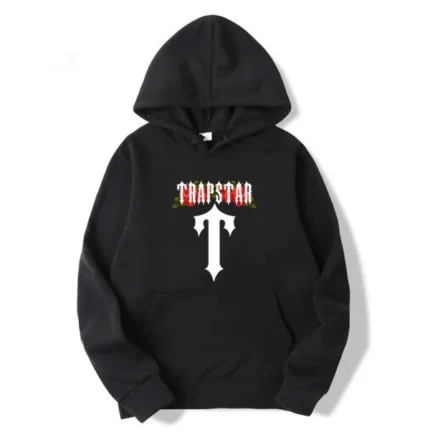Trapstar is one of the most recognized names in streetwear, representing a fusion of urban culture, music, and fashion. Founded in 2005 in West London by Mikey Trapstar, Lee, and Will, Trapstar began as a small, underground streetwear brand with a rebellious attitude and an inclusive approach to fashion. Over the years, the brand has evolved into a globally respected name, worn by celebrities and embraced by streetwear enthusiasts worldwide. Its unique blend of edgy designs, bold graphics, and deep-rooted ties to music and street culture has positioned Trapstar as a dominant force in the fashion world.
The Origins of Trapstar: A Brand Built on Authenticity
Trapstar was born from humble beginnings, created by three friends who wanted to merge their love for fashion, music, and street culture into a brand that represented their lifestyle. Trapstar was born from humble beginnings, created by three friends who wanted to merge their love for fashion, music, and street culture into a brand that represented their lifestyle. The name “Trapstar” itself reflects the fusion of the “trap” (a term often associated with hustle and the grind in the street culture) and “star,” symbolizing ambition, success, and aspiration.
The name “Trapstar” itself reflects the fusion of the “trap” (a term often associated with hustle and the grind in the street culture) and “star,” symbolizing ambition, success, and aspiration.
From the start, Trapstar embraced a DIY ethos. Initially, the founders would hand-print T-shirts and sell them to friends and locals. What made the brand stand out was its authenticity. The designs were raw, bold, and unapologetic, echoing the gritty realities of urban life, while also offering a sense of empowerment and aspiration. Their commitment to creating something true to their own experiences and backgrounds resonated with their growing fan base, and word of mouth quickly spread across London’s underground scene.
Trapstar’s Aesthetic: Dark, Edgy, and Iconic
Trapstar’s visual identity is distinct, characterized by dark color palettes, bold typography, and rebellious motifs. The brand’s designs often feature cryptic messages, stark contrasts, and military-inspired graphics. Trapstar embraces a minimalist approach to color, typically opting for blacks, greys, and reds, which gives the clothing a sleek, yet gritty, look.
One of the brand’s most iconic designs is the “IT’S A SECRET” slogan, which appears on many of its pieces. This tagline speaks to the brand’s elusive, underground roots, adding an air of mystery to its identity. Other recurring elements in Trapstar’s collections include camouflage prints, skulls, and gothic fonts, which align with the brand’s overall dark and rebellious aesthetic.
The aesthetic choices made by Trapstar reflect the brand’s connection to London’s street culture, particularly its ties to grime and hip-hop music. This connection is part of what has made Trapstar so successful—it authentically represents the lifestyle and culture that surrounds it, without feeling forced or contrived.
Trapstar’s Music Connection: From Grime to Global Recognition
Music has always been at the core of Trapstar’s identity. From the very beginning, the founders of Trapstar were closely connected to London’s grime scene, a genre that shares many cultural ties with streetwear. Trapstar’s rise coincided with the growth of grime, and the brand became a favorite among grime artists like Skepta, Stormzy, and Wiley.
The brand’s popularity in the music scene helped elevate its profile beyond the streets of London. As grime and UK hip-hop gained international attention, Trapstar became a symbol of the culture. The brand’s visibility skyrocketed when high-profile artists like Rihanna, Jay-Z, and A$AP Rocky were seen wearing Trapstar pieces. Jay-Z’s particular endorsement of the brand was a game-changer, as he was one of the first international celebrities to publicly support Trapstar, giving it credibility and exposure on a global scale.
Trapstar’s close relationship with music culture continues to be a major factor in its success. The brand regularly collaborates with musicians and incorporates music into its marketing strategies, ensuring that it remains closely aligned with the culture that inspired it.
Celebrity Endorsements: Fueling Trapstar’s Global Popularity
One of the key factors that propelled Trapstar from an underground label to a globally recognized brand is its celebrity endorsements. High-profile celebrities across music, sports, and entertainment industries have been seen wearing Trapstar, helping to elevate its status. As mentioned, Rihanna and Jay-Z’s support of the brand was instrumental in raising Trapstar’s profile, but many others have also contributed to its success.
In addition to grime artists and rappers, international stars such as Cara Delevingne, The Weeknd, and Lewis Hamilton have been seen wearing Trapstar. This crossover appeal between music, fashion, and sports has solidified Trapstar’s place as one of the top streetwear brands on the global stage.
These endorsements haven’t just come in the form of artists wearing the clothes, but through collaborations as well. Trapstar has worked with major names in the entertainment industry to produce exclusive pieces, further embedding the brand within the worlds of fashion and music.
Trapstar Collaborations: Expanding the Brand’s Reach
Trapstar’s collaborations have played a significant role in expanding its reach and solidifying its status as a major player in streetwear. One of the most notable collaborations is with PUMA. This partnership brought Trapstar’s edgy designs to a broader audience, with the launch of co-branded sneakers and apparel that sold out almost instantly. The Trapstar x Puma collaboration successfully merged the worlds of streetwear and athletic wear, combining Puma’s sportswear expertise with Trapstar’s signature rebellious style.
Another important collaboration came with Vans, a brand deeply rooted in skate culture. The Trapstar x Vans collaboration resulted in limited-edition sneakers that featured Trapstar’s iconic branding and color schemes, further connecting the brand with a wider range of streetwear consumers.
Trapstar has also collaborated with Call of Duty, blending gaming culture with fashion in a unique way. This collaboration showcased Trapstar’s ability to tap into different subcultures, creating a diverse following that spans music, sports, gaming, and beyond.










